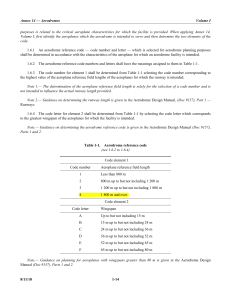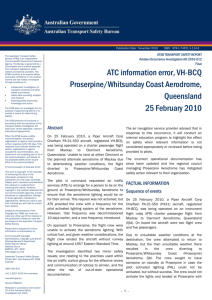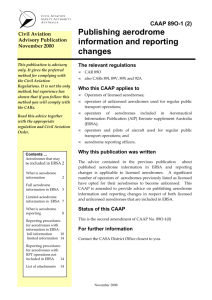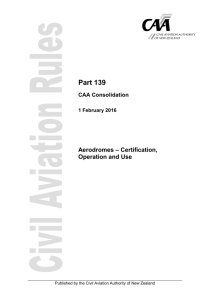lecture notes
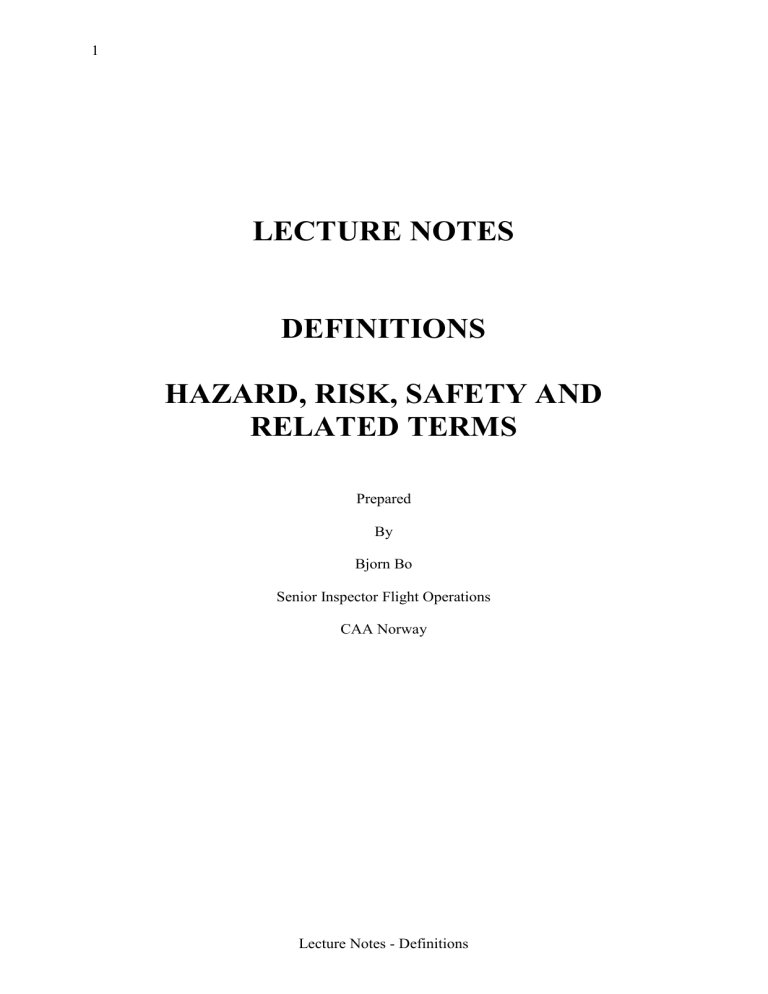
1
LECTURE NOTES
DEFINITIONS
HAZARD, RISK, SAFETY AND
RELATED TERMS
Prepared
By
Bjorn Bo
Senior Inspector Flight Operations
CAA Norway
Lecture Notes - Definitions
2
HAZARD, RISK, SAFETY AND RELATED TERMS.
TABLE OF CONTENTS
1.0 HAZARD
2.0 RISK
3.0 PROBABILITY
4.0 CONSEQUENCES
5.0 ALARP (As Low As Reasonably Practical)
6.0 SAFETY
7.0 SAFETY PERFORMANCE INDICATORS
8.0 SAFETY MANAGEMENT SYSTEM
9.0 RISK ANALYSIS
INTRODUCTION
In this workshop we are going to use the words HAZARDS, RISK, SAFETY, SAFETY
MANAGEMENT, RISK ANALYSIS and other terms to a large extent.
Maybe some time spent discussing some of these key words could be useful.
1.0 HAZARD
A hazard is a scenario which, if it occurs, can have negative consequences to personnel, material (or the environment).
Typical hazards that can occur on or in relation to aerodrome design and operation include, but are not limited to the following:
An aeroplane departing the runway (undershoot, overrun, veer-off)
An aeroplane departing other parts of the movement area (taxiways)
An aeroplane colliding with another aeroplane, vehicle, pedestrian or wildlife on the runway
(Runway incursion)
An aeroplane colliding with another aeroplane, vehicle, pedestrian, wildlife or structure on other parts of the movement area.
Vehicle colliding with an aeroplane on the movement area (typically on the apron)
Foreign Object Damage (to engines or other parts of the aeroplane)
An aeroplane colliding with obstacles during approach, low over-flight or climb-out.
An aircrew being misled by lights which may cause confusion or endanger the safety of aircraft.
Hazards can occur, usually, due to several causes.
If the hazards are identified and also the factors contributing to the occurrence of the hazard, it is (not always) possible to estimate the probability of a hazard occurring and the consequences of the hazard.
Thus it is possible to estimate the risk associated with the hazard.
Lecture Notes - Definitions
3
Before we discuss the term Risk, we can also note that with the same information available, it is also possible to identify factors that can mitigate the probability and/or the consequences of a hazard.
2.0 RISK by definition is the product of PROBABILITY and CONSEQUENCES.
3.0 PROBABILITY (formally a number between 0 and 1) is usually expressed in terms of events pr (million) flight hours. This in reality is probability given an exposure.
When talking safety in connection with aerodromes, it is more fruitful to express probability in terms of movements (or million of movements).
It is sensible to do so for two reasons.
Firstly, an incident/accident at an aerodrome usually takes place in connection with take-off or landing, i.e. in connection with movements.
Secondly, aerodromes usually have good statistical data on movements, as these form the basis for income (landing fees).
PROBABILITY can also be expressed in qualitative terms like Extremely Improbable,
Extremely Remote, Remote, Reasonably Probable or Frequent.
These examples are taken from design rules for transport category aeroplanes.
Probability of occurrence definitions
Probability of
Occurrence classification
Qualitative definition
Quantitative definition
Extremely improbable
Should virtually never occur in the whole fleet life.
< 10
-9
per flight hour
Extremely remote
Unlikely to occur when considering several systems of the same type, but nevertheless, has to be considered as being possible
10
-7
to 10
-9
per flight hour
Remote
Unlikely to occur during total operational life of each system but may occur several times when considering several systems of the same type
10
-5
to 10
-7
per flight hour
Reasonably probable
May occur once or a few times during the total operational life of a single system
10
-3
to 10
-5 per flight hour
Frequent
May occur once or several times during operational life
10
-3
per flight hour
NOTE: As there are usually a number of causal factors that contribute to the risk budget of an undesired event, the probability of each item is (arbitrarily) set one or two orders of magnitude greater than in the table above.
Lecture Notes - Definitions
4
4.0 CONSEQUENCES
Consequences are usually described qualitatively with words like Catastrophic, Hazardous,
Major or Minor.
Catastrophic
the loss of the aircraft
multiple fatalities
Hazardous
a large reduction in safety margins physical distress or a workload such that the flight crew cannot be relied upon to perform their tasks accurately or completely
serious injury or death of a relatively small proportion of the occupants
Major
a significant reduction in safety margins
a reduction in the ability of the flight crew to cope with adverse conditions as a result of increase in workload or as a result of conditions impairing their efficiency
injury to occupants
Minor
nuisance
operating limitations: emergency procedures
It is, presumably, intuitive that we accept minor incidents more frequently than major disasters.
Thus it is possible to set up a Tolerability Matrix.
Review Unacceptable Unacceptable Unacceptable Unacceptable
Catastrophic
Hazardous
Major
Minor
Review
Acceptable
Review
Review
Unacceptable
Review
Unacceptable
Review
Unacceptable
Review
Acceptable Acceptable Acceptable Acceptable Review
Extremely improbable
Extremely remote
Remote Reasonably probable
Frequent
The words acceptable and unacceptable are self-explanatory. The term “review” means that if a scenario falls into a review category, an exercise should be carried out to see if it is possible to put in place mitigating measures to either reduce the probability or the consequences (or both) of the scenario in order to reclassify it as acceptable.
Lecture Notes - Definitions
5
5.0 ALARP (As Low As Reasonably Practical)
An objective of the Safety Management System is to reduce the risk to As Low As
Reasonably Practical.
What does this mean?
The following figure can be used to illustrate the principle:
Figure.
Unacceptable region
Risk cannot be justified save in extraordinary circumstances
risk “limit”
The ALARP (as low
Tolerable only if risk reduction is impracticable or as reasonably practicable) or if its cost is grossly disproportionate to the
Tolerability region
(risk undertaken improvement gained only if a benefit is desired)
Tolerable if cost of reduction would exceed the improvement gained
risk “target”
Broadly acceptable region
Necessary to maintain assurance that risk remains at this level
One must establish a risk limit.
If a certain scenario is deemed to have a risk greater than the limit, mitigating measures must be put in place to reduce the risk below this level.
One must also establish a risk target.
If a certain scenario is deemed to have a risk lower than the target, fine. Concentrate your efforts on other scenarios.
The risk target could for example be set one order of magnitude below the risk limit.
If a certain scenario is deemed to have a risk below the limit, but above the target, one should review the case. If it is relatively simple (in practical and economical terms) to put in place mitigating measures to reduce the risk towards the target, please do so. If not, accept and concentrate on other scenarios.
Lecture Notes - Definitions
6
6.0 SAFETY
Several definitions exist.
ICAO Doc 9735, Safety Oversight Manual” has this definition:
A condition in which the risk of harm and damage is limited to an acceptable level.
The Air Navigation Commission (ANC) has adopted the following definition of Aviation
Safety:
The state of freedom from unacceptable risk of injury to persons or damage to aircraft and property.
Another way of saying basically the same is to say that acceptable SAFETY means that all risk levels are kept below the risk limits, reference the ALARP figure, or that all hazard scenarios are kept in the acceptable region of the Tolerability matrix.
7.0 SAFETY PERFORMANCE INDICATORS
Is it possible to develop a limited set of parameters that are easy to follow up and which gives a sufficiently clear picture of the safety status of the aerodrome, and which at an early stage will give the aerodrome management a hint that some aspect of the operation is about to deteriorate so that corrective action can be initiated before the situation gets out of hand.
We will cover this in more detail when we look into Safety Management Systems, but some words of introduction are in order.
Fatal accidents per million movements is not a good indicator for an aerodrome because, hopefully you will have no fatal accident.
As said earlier, when we talked about hazards, several factors usually contributed. Whereas the result of these factors being present does not necessarily result in an accident, the potential is there.
So, it is important to register, record and minimise the existence of such factors.
Some suggestions are offered:
Some possible examples of critical conditions in relation to airport operations which could be elements of key indicators:
- Movement area safety
Violation of local traffic rules (vehicles)
Unauthorised personnel on the airside
Lecture Notes - Definitions
7
-
Incidents and accidents on the apron involving, personnel, aircraft or ground equipment
Etc
.
Pavement maintenance
FOD cases actual
FOD cases potential
Bird strikes
Occasions when birds were scared away
Worn markings
Etc
-
-
Winter operation
Temporarily cleared runway in relation to movements or business hours
Fully cleared runway in relation to movements or business hours
Movements on friction levels below 0.30, 0.25 or at 9
Etc
Errors in the reporting chain
Electrical services
Disruption of primary power supply
Reduced serviceability of one or more light systems
Unserviceability of one or more light systems
One or more obstacle lights unserviceable more than x hours at a time.
Signs out of service
Etc
- Fire fighting and rescue
Cases of increased alert level (should be greater than zero)
Exercise frequency, all types
Response time more than 90 seconds
Reduced category in relation to traffic
Certain resources out of service more than xx hours at a time (ex rescue boats if they are part of the emergency plan)
Use of not fully qualified personnel
.
Examples of possible timeframes (denominators)
Per x movements
Per hour of business
Per day, week, month, year ......
In relation to what it should have been etc
This must be chosen for each type of occurrence to make sense.
Lecture Notes - Definitions
8
8.0 SAFETY MANAGEMENT SYSTEM
A definition can be found in Doc 9774.
Safety management system. A system for the management of safety at aerodromes including the organizational structure, responsibilities, procedures, processes and provisions for the implementation of aerodrome safety policies by an aerodrome operator, which provides for the control of safety at, and the safe use of, the aerodrome.
If we dissect the definition we can find some useful information.
There shall be a system, and as a corollary, a systematic approach to safety.
Safety shall be managed and controlled.
There must be an organisation with structure and defined responsibilities.
There must be procedures.
There must be a safety policy which shall be implemented.
And the objective, the Aerodrome shall be safe for operation.
We will go more into the details in a separate session.
9.0 RISK ANALYSIS
A systematic approach for describing and/or calculating risk. Risk analysis involves the identification of undesired events, and the causes and consequences of these events.
A risk analysis can be quantitative. However, this requires the existence of suitable data.
(relevant and reliable)
A risk analysis can also be qualitative.
In either case, the following elements should be included:
A description of problems and objectives
Selection of procedures, methods and data sources
Identification of undesired events
An analysis of causal factors and consequences
A description of risk
Mitigating measures
Presentation of results
Based on the last item, a comparison with the tolerability matrix can be made, and also the results of the risk analysis should be useful in identifying risk mitigating measures.
END
Lecture Notes - Definitions
